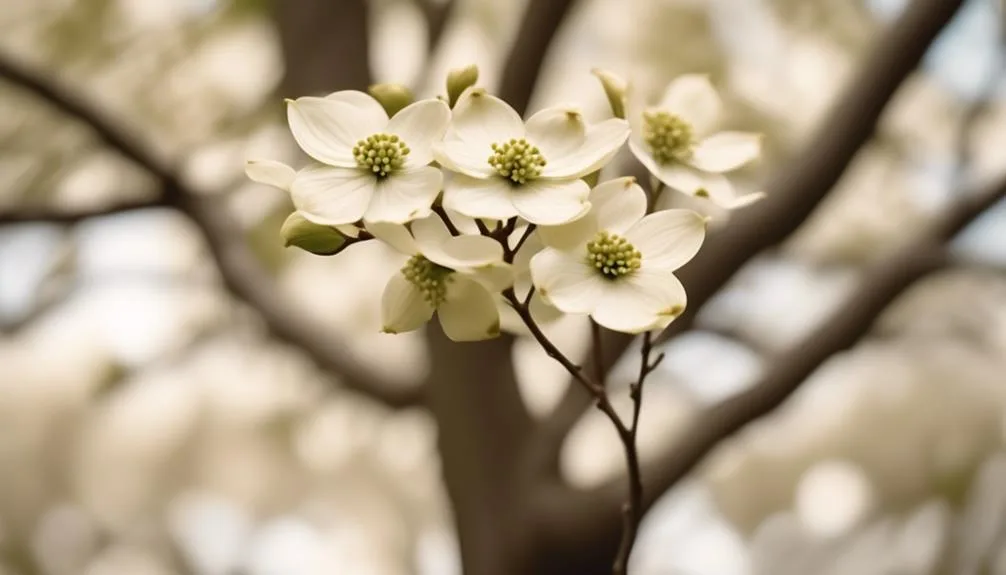Ever noticed how dogwood trees grow so compact and charming? It's a result of genetics, environment, evolution, and human cultivation.
Understanding the reasons behind their growth habit offers insight into plant biology and the relationship between trees and their surroundings.
Picture walking through a forest and stumbling upon a dogwood tree with delicate white blossoms. The reasons behind its unique growth habit are fascinating and tell a story of nature's influence on plant life.
Genetic Factors
Understanding the genetic factors that contribute to the compact growth habit of dogwood trees is essential for breeders and horticulturists seeking to cultivate desirable traits in new varieties.
Inheritance patterns play a crucial role in determining the compact growth habit seen in certain dogwood tree species. This trait can be passed down from parent trees to their offspring through specific genetic mechanisms.
DNA mutations also contribute to the development of compact growth habits in dogwood trees. These mutations can alter the expression of genes related to growth and branching, leading to the characteristic compact form.
Environmental Influences
The genetic factors contributing to the compact growth habit of dogwood trees set the stage for their interaction with various environmental influences, shaping their development and overall appearance.
Climate conditions and soil composition play a crucial role in determining the growth of dogwood trees. Sunlight exposure directly impacts their growth and flowering patterns, influencing their overall compactness. Moisture levels in the soil also affect the growth habit of dogwood trees, as they require well-drained soil to thrive.
The interplay of these environmental factors can either enhance or hinder the compact growth habit of dogwood trees, making them particularly sensitive to their surroundings.
Adaptive Evolution
With adaptive evolution, dogwood trees fine-tune their growth habits to thrive in diverse environments, showcasing their remarkable ability to respond to changing conditions. Natural selection plays a crucial role in this process, as dogwood trees adapt to fit within their ecological niche. By evolving to suit specific environmental factors, such as light availability, soil composition, and moisture levels, dogwood trees increase their chances of survival and reproduction. This adaptability allows them to occupy various ecological niches, from forest understories to open meadows, ensuring their continued existence in a range of habitats. The table below illustrates the key factors influencing the adaptive evolution of dogwood trees.
| Environmental Factor | Adaptive Response |
|---|---|
| Light Availability | Compact growth habit to thrive in shaded conditions |
| Soil Composition | Fine-tuned root system to absorb nutrients efficiently |
| Moisture Levels | Ability to withstand periods of drought through water storage |
| Competition | Efficient resource allocation for optimal growth and reproduction |
Horticultural Practices
Wondering how to best care for your dogwood trees? Proper horticultural practices can help ensure healthy growth and beautiful blooms. Here are some tips to help you maintain your dogwood trees:
- Pruning Techniques: Regularly prune your dogwood trees to remove dead or diseased branches, promote better air circulation, and shape the tree to your desired form. Pruning should be done during the dormant season to avoid stressing the tree.
- Soil Composition: Dogwood trees thrive in well-drained, slightly acidic soil. Consider adding organic matter, such as compost or peat moss, to improve soil structure and fertility. Mulching around the base of the tree can also help retain moisture and regulate soil temperature.
Conclusion
Implementing these horticultural practices will help you ensure the health and longevity of your beloved dogwood trees. By understanding the growth patterns and botanical characteristics of dogwood trees, you can create an optimal environment for these beautiful plants to thrive. Remember to provide adequate water, sunlight, and nutrients to support their growth. Pruning and shaping your dogwood trees will encourage a compact growth habit, enhancing their aesthetic appeal while maintaining their overall health. Observing and appreciating the natural beauty of your dogwood trees will bring joy and tranquility to your surroundings. Your efforts in caring for these trees will be rewarded with an enchanting display of blossoms each spring, creating a picturesque landscape for you to enjoy.
| Growth Patterns | Botanical Characteristics | Emotional Response |
|---|---|---|
| Compact growth habit | Showy flowers and colorful foliage | Joy and tranquility |
Conclusion
In understanding the factors behind a dogwood tree's compact growth, we gain a deeper appreciation for these beautiful trees.
Genetic elements, environmental influences, adaptive evolution, and horticultural practices all contribute to their charm.
By nurturing these trees, we continue to enjoy their stunning beauty and contribute to their thriving presence in our surroundings.
Mark Hoffman is a dedicated arborist and tree care specialist with over a decade of experience. His love for trees began when he visited Yosemite National Park as a teenager and was awestruck by the giant sequoias. Mark pursued his passion by studying forestry at Michigan Technological University, where he earned a Bachelor of Science degree.
Since then, he has worked tirelessly in the field of arboriculture, helping to preserve and protect trees in his community. His expertise and dedication have made him a respected leader in the industry and a valuable resource for anyone seeking advice on tree care.
